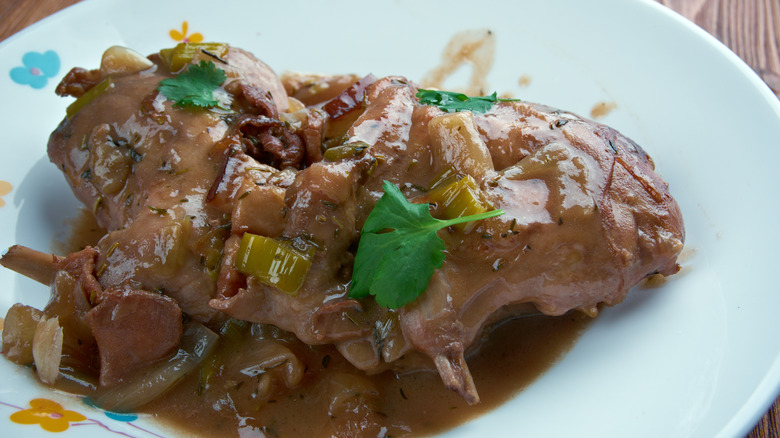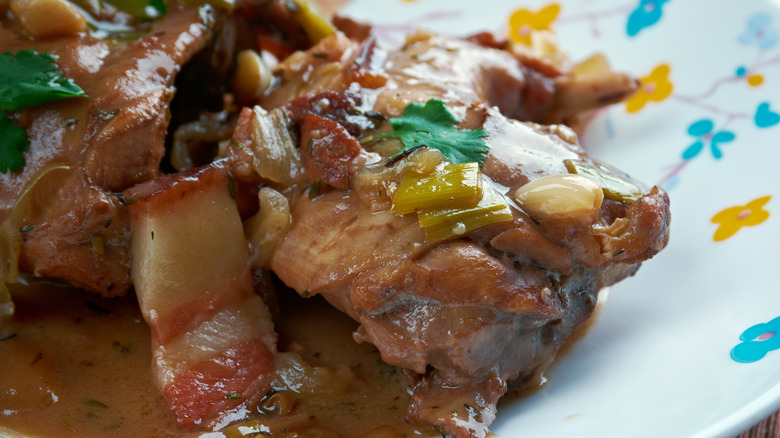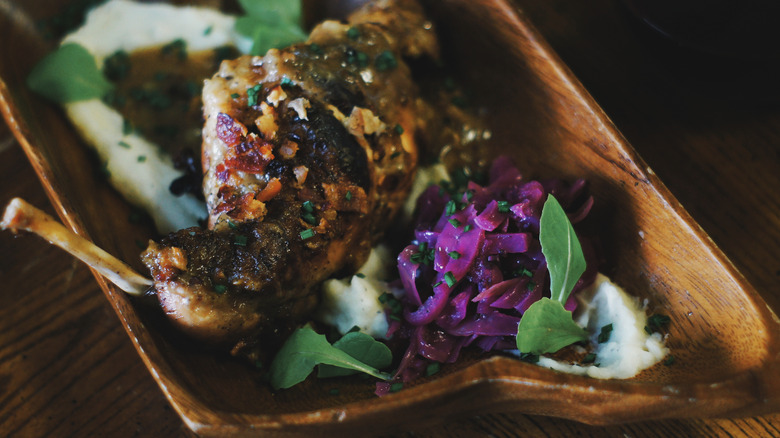Hasenpfeffer: The German Rabbit Stew You Need To Make ASAP
While Laverne and Shirley might have sung about "hasenpfeffer incorporated," that pop culture reference was not necessarily touting the love of the German rabbit stew. Even though those Milwaukee-based characters might enjoy a hearty, spiced bowl on a chilly day, this classic recipe has been around for centuries.
The term "hasenpfeffer" combines two German words. Hase means "hare" and "pfeffer" translates to pepper. Specifically, the slow, simmered stew is flavored by a spicy vinegar marinade. While that sourness might be pungent, the acid helps to break down the sometimes tough game meat. As the protein slowly absorbs the liquid, the tough tendons relax and give way to fall off the bone tenderness when it stews.
Lingering in the flavor background is the pepper. Although not a bold, chile pepper type heat, the flavor features black pepper, and often other herbs and spices. Game meat often needs a robust amount of seasoning due to its more pronounced gamey flavor. The pepper, herbs, and other seasonings help to balance the pungent notes. In a way, "incorporating" flavor into the hasenpfeffer requires more time than skipping down the street to a television song opening.
Hasenpfeffer requires two separate cooking steps
Since hasenpfeffer uses rabbit as its primary ingredient, the game meat requires extra steps to ensure a tender, fall-off-the-bone result. The first step is to allow the rabbit to marinade for up to 24 hours. While exact ingredients can vary, generally it includes vinegar, wine, herbs, and spices. The acid in the vinegar helps to break down the fibrous game meat, while the other ingredients help to tame the gaminess of the rabbit. When choosing herbs and spices consider woody, piney, or earthy notes that can complement the hearty flavors of the rabbit.
Another essential cooking step for the hasenpfeffer is to brown the meat before it stews. Once the marinated rabbit is thoroughly dried, coat it in seasoned flour. Then, sear the protein in oil, lard, or another form of fat. This step helps to seal in flavor and create a more appetizing appearance.
As the rabbit stews, the meat will slowly pull away from the bone. The liquid reduces and the resulting gravy reveals the beautifully braised meat. The slight crust from the browned rabbit contrasting the soft vegetables is visually enticing when it arrives on the plate. Even though the dish's name might be as difficult to say as rascally rabbit, the flavor is worth all the effort to present it at the table.
What should be served with hasenpfeffer?
While the tender, fall-off-the-bone rabbit is the star of hasenpfeffer, the protein needs a side. Spaetzle, the traditional German dish are short strands with dumpling-like, chewy consistency. Made by drizzling the batter into boiling water, the unevenly-shaped pieces absorb flavor from sauces. Given that the hasenpfeffer has a rich sauce, the spaetzle becomes yet another layer to the flavorful dish.
Instead of spaetzle or dumplings, potatoes are also a common choice. Since potatoes can be cooked many different ways, and are more of a blank slate when it comes to flavor, the starch takes on the spices and seasonings. A heaping scoop of mashed potatoes can be smothered with the stew gravy. Or, diced potatoes can offer a contrast of texture where a forkful can dipped into the sauce on the plate. Basically, the potato side dish helps to ensure none of the luscious stew liquid goes to waste.
Since hasenpfeffer is a rustic, hearty dish, the side dishes can take inspiration from that concept. While it might not be as directly connected as what grows together goes together, the garden where that rabbit forages could be a source for side dishes. Roasted root vegetables, like carrots or turnips, bring sweetness while supporting the earthy spices of the hasenpfeffer. Also, carrots can be the pop of color on an otherwise brown plate. While hasenpfeffer might be hard to pronounce, the flavor will have everyone hopping to the table for another serving.


